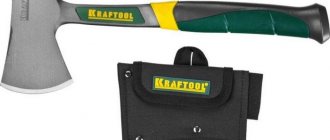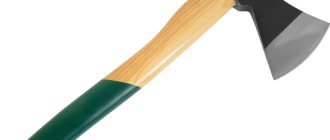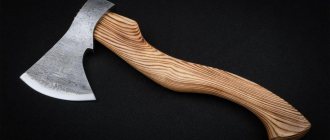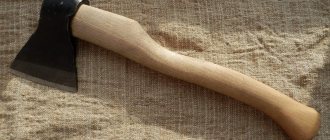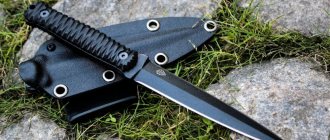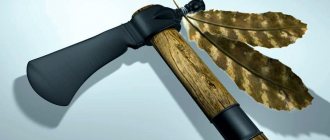Whether you're building a camping kit, a craft kit, or a bug out bag, an ax is a tool that shouldn't be overlooked in your preparation. Axes have been used for thousands of years for a variety of daily and survival activities, and have earned a reputation as reliable and effective tools...
Modern axles maintain this heritage as they evolve to meet the multifaceted needs of today's survivors and nature lovers. In fact, few tools offer practical, tactical and survival uses for the axe.
Considering the abundance of models on the market and the different purposes they serve, choosing an ax to include in your kit can take some time and deserves careful consideration. In general, however, the best tactical ax has a broad utility that can be used in multiple tasks over a long period of time without damaging the tool...
While choosing one can be a difficult task, these reviews reveal 7 axes that will be a great tactical addition to your kit.
What is a tactical ax?
Contrary to popular belief, tactical axes are not only used in video games such as Call of Duty and Skyrim. In fact, axes have been used for centuries as man has developed his abilities and become more self-sufficient. Archaeological evidence shows that the first cities that used axes were able to build larger, stronger, and more complex shelters than those who did not have access to this tool...
That's why seasoned outdoorsmen and survivalists know that leaving home without a tactical ax puts them at a disadvantage in the wilderness. Compared to a knife, an ax is a more effective tool in a variety of outdoor conditions.
From chopping wood to building an emergency shelter to quickly handling the game, a tactical ax allows you to accomplish tasks you might not be able to accomplish with just a knife or machete, while increasing your confidence in the outdoors.
The tactical ax is thus a special type of ax within a wide range of similar tools. While there are dedicated work axes for tasks such as throwing or cutting, tactical axes provide multi-purpose functions that cover these specific tasks and more. If you're looking for a tactical axe, you're looking for a versatile and durable tool that performs a wide range of functions quickly and efficiently.
History of the tomahawk
This type of bladed weapon has a centuries-old history. Despite this, it is not so familiar to the “pale-faced” population of the planet.
Only limited collections of the battle ax - tomahawk - are produced. Since ancient times, it has been entrenched in the consciousness as a cold weapon of the Indian tribes of North America. His appearance was different from that shown in the films.
Indian tomahawk.
If you dig deeper into history, it turns out that the designation of this weapon existed long before the discovery of America by Columbus - tomahiken, tomahak, tomehogan. These terms denoted a thick stick with a sharp stone tip.
It was also used as a pipe for smoking herbs.
The appearance of steel tomahawks among the Indians
Oddly enough, the idea of creating and using the tomahawk belongs not to the Indians, but to the Europeans. The latter brought interesting steel axes to the American continent, which the local population immediately appreciated - they bartered for fur.
Over time, the Indians made it into a military weapon, learned to use it in close combat, and as a throwing weapon over long distances (up to 20 m), accurately hitting the target.
It was a convenient tool compared to knives and spears: the lever handle inflicted chopping wounds, the ax of optimal length made it easy to fight both in close combat one on one and in a crowd. Another purpose is hunting.
Over time, the tastes of the Indians changed according to the models produced - Missouri battle axes, espontone tomahawk. The design was improved - artistic engraving, inlay with gold and silver. They were given as a sign of respect, peace and friendship, and were used in ritual events.
Indian tomahawk axe.
Vietnamese tomahawk by Peter Lagrana
The tactical ax was successfully used by settlers until the 1850s: for hunting, in construction, and by the military. It was used by American troops during the War of American Independence against the British colonists and their accomplices. For some time, the tomahawk was consigned to oblivion - supposedly it was no longer so effective and modern.
The resurrection of this type of weapon occurred thanks to the efforts of the Indian Peter LaGrana. He was a hand-to-hand combat teacher and also taught tomahawk fighting techniques.
Having demonstrated the capabilities of the tactical ax on mannequins, the US armed forces actively began to use it in combat operations, for example, during the Vietnam War (1966-1975).
Peter LaGana himself designed an army tomahawk with maximum combat capabilities: a highly sharpened blade, ideal proportions and weight for successful throwing at a distance of 5-6 meters without special training. He has been producing this series himself since 1966.
Since that time, the Marine Corps began to use the ax. In 1970, the company ended its activities. Of the total number of tomahawks produced, 90% were purchased by Marines who participated in the war with Vietnam. Therefore, the weapon was called the “Vietnamese tomahawk.”
Army tomahawk.
What can a tactical ax do?
The tactical ax performs a wide range of functions and tasks. Some of the most popular uses of the tactical ax include
- cutting,
- curious,
- rape,
- Hunting/processing and
- Piercing/cutting.
cutting
Perhaps the most basic use of a tactical ax is as a cutting tool. You don't have to venture deep into the wilderness to use your ax for the job: tactical axes make it easy to cut wood for your backyard fireplace or stove...
However, in tactical or survival scenarios, the right ax makes quick work of a fallen tree or a tree that is still standing, with its ability to cut down abundant vegetation, including tree trunks...
curious
The tactical ax's load lever can help you open any number of items. From cans to sewer grates, your ax can cut open objects that are stuck or sealed, especially when they are needed for survival. Also in search and rescue situations, you can use a tactical ax to open doors or windows and gain access to a building.
rape
Likewise, the tactical ax can be used to destroy buildings, vehicles, shelters and dense vegetation...
While his ability to rape can help him in self-defense, the ax can also help him save others who may be in danger. A tactical ax can break glass to help escape a burning building; It can also be an important tool in vehicle rescue.
Hunting/Recycling
The versatile design of the tactical ax makes it an effective hunting tool. Few, if any, other tools are as effective in the hunting and handling game as the tactical axe. With a tactical axe, there's no need to bring multiple tools for different hunting assignments: you can use the same tool to handle the game as you do for the knockdown.
This is important in wildlife and survival situations where the amount of time spent gathering food can mean the difference between life and death...
Piercing/cutting
Finally, the tactical ax is capable of completing the most delicate jobs in an efficient and effective manner thanks to its multi-faceted design. The game of skinning, cutting material and drilling or drilling into various objects is made easier with the help of a tactical axe. The tactical ax is extremely useful in complex or precise tasks that require a delicate hand.
Overall, while most tactical axes can perform each of these tasks to a greater or lesser extent than the others, you should choose a tool designed to meet your specific needs.
Probing, cutting edge, and handle length all affect an ax's performance in certain areas and skills, so it's important to understand the design and construction of the ax you're considering purchasing.
How to choose a tactical ax
The design of a tactical ax affects the ease with which you can perform cutting, leverage, rape, hunting, drilling and other tasks.
For example, an ax used primarily for chopping and prying tasks will differ in style and performance from an ax intended for self-defense or search and rescue. To determine the correct style for its intended use, you must evaluate the ax
- innovative,
- Survey and
- Handle length.
innovative
The vanguard of modern axles is very different from traditional axles in that it offers the owner more features and additional ribs. In addition to the main edge, a tactical ax blade also includes a top edge, called the spine, and a bottom edge, usually at an angle, called the beard.
While the spine and beard can be sharp or utilitarian in all ax models, they provide benefits and alternatives, especially when used for self-defense, cutting, or carving tasks. Anyone who plans to use their ax primarily for these tasks may be interested in an ax with a sharp spine and beard.
Additionally, the length of the main edge of an ax head affects the ease with which the tool performs certain types of tasks. For example, the long edge is ideal for cutting and chopping wood or getting over barriers; The narrow edge, on the other hand, excels at drilling through heavy materials, making it ideal for search and rescue, self-defense, and mining.
It should be kept in mind that the longer the blade, the heavier the ax head. While this extra weight adds strength and power to your swing, it also causes fatigue faster, so it's important to carefully weigh the pros and cons of edge length before making a decision.
opinion poll
The butt, also called the butt, is the rear part of the axe. Traditionally rounded or flat, some tactical axes have a pointed view that can be used for penetration and defense. Again, the type of survey you choose depends on the basic tasks you want to accomplish with the axe, or the tactical problems you want to solve.
Flat or round surveys are excellent for hammering, shelling, and disruption, while spot surveys are effective for intrusion, drilling, and defense.
Handle length
The length of the ax handle also affects not only the use of the tool, but also the ease of use and fatigue you will experience while using it...
Longer handles provide more leverage than shorter handles; Long-handle axles are ideal for lifting open objects and adding strength when cutting or balancing, but they are also heavier and more difficult to transport than short-handle axles.
Shorter handles are lighter, more compact, and easier to fit into a backpack or kit than long-handled hatchets, making them effective in tight spaces, but lacking the impact and balancing power of a model. long handle Some of the most common uses of each type of mango include:
Long handle:
- Wood cutting
- Tree cutting
- Open doors
- Violation of buildings and vehicles, especially when forced entry for search and rescue
- Impact of heavy materials
- Big Game Handling
Short handle:
- Self-defense
- drilling
- Cut, slice or carve with precision
- release
- Evacuate buildings and vehicles.
- Handling a small game
5 More Formidable Battle Axes
A battle ax in skillful hands is a universal tool: it can pull a rider off a horse, find a vulnerability in armor, or chop a shield into pieces. Today we will continue our story about what kind of axes stern warriors all over the world used to fight in the past.
Last time we talked about the five most famous battle axes of bygone eras. Of course, the variety of types of this wonderful weapon does not end there. Today we will talk about several more of the most interesting types of battle axes and demonstrate why over time they have literally become a universal method of fighting in close combat.
Tomahawk
The tomahawk is a North American Indian battle axe. Initially, tomahawks (English transliteration of the original dialect of the Indians) were called various clubs and clubs, the favorite weapons of the aborigines. Afterwards this name was transferred to metal axes, but some language groups also retained their own designations for these weapons.
Tomahawks are very diverse. The “boat” tomahawk is characterized by a butt with a cup for smoking mixtures, while the “esponton” tomahawk has a blade perpendicular to the handle. In addition, a small hammer or an additional point could be attached to the butt. Often the pommel was decorated with a pointed horn or spike - the result was a miniature halberd.
Thanks to the media, many believe that the tomahawk is an exclusively throwing weapon, and that the Indians threw them in one gulp, like the Roman legionaries threw their pilums. History and common sense say the opposite: a tomahawk is a melee weapon, and although throwing it is convenient, a warrior will take such a step only in case of emergency.
Franziska
Francis, as you might guess from the name, was the battle ax of the Franks and other Germanic tribes. It became most widespread among the Merovingian Franks in the 5th-6th centuries. Two varieties of Francis are known: for close combat and for throwing.
An ax for close combat was mounted on a long (a meter or more) ax handle, which made it possible to take it with both a one-handed and two-handed grip, which is very important for an ax. The ax of throwing Francises was shorter than the length of a warrior's arm, but still noticeably longer than that of other throwing axes.
Lochaberakst
The Lochaber ax got its name in honor of the locality of Lochaber, in Scotland. A long infantry ax resembles a reed: a one and a half meter shaft is crowned with a long (up to 50 cm), smooth blade, more like a halberd rather than an ax. Often the edge of the blade was wavy: like the flamberges, this gave the weapon excellent cutting properties and made it possible to literally saw through the thinnest areas of armor.
Considering the abundance of heavily armored combat units in the armies of the 14th-16th centuries, the popularity of the lochaberakst is quite understandable. A hook was often attached to the butt, which could be used to pull riders out of their saddles and pull infantrymen out of tight formation. Such versatility made the weapon indispensable: there is an opinion that the halberd appeared precisely as an evolution of the Lochaber ax.
Halberd
In fact, the halberd is no longer a classic battle ax, but an independent subtype of polearm bladed weapon. It is characterized primarily by a combined warhead: in addition to the chopping edge of the axe, the top of the halberd was decorated with a long faceted tip of a spear point, and the butt was equipped with a hook or counterweight spike. The long (1.5-2.3 meters) shaft made the halberd an excellent weapon against cavalry: a detachment bristling with halberds could stop even heavily armored cavalry at full gallop.
As in the case of the lochaberax, what made the halberd popular is its versatility: with this weapon you can stab, chop, and cut the enemy, while maintaining an impressive distance between him and you. The handle, protected with steel strips, protected the shaft from being cut, but even without these precautions it is very difficult to cut a long, smooth pole. There was also a boarding modification of the halberd: it was equipped with a large hook and an even longer (up to 3 meters) shaft.
Glaive
A glaive, also known as a glaive, is another type of pole weapon, which is a cross between a spear and an axe. It consists of a one and a half meter shaft and a tip in the shape of a narrow, elongated crescent, the length of which reaches 40-60 cm. A distinctive feature of the glaive is the “sharp finger,” which is a sharp tip of the butt, directed perpendicularly or at a slight angle to the blade. With its help, you could grab the enemy’s weapon or try to pierce him yourself.
Last words
The following table provides a quick comparison of the main uses and price rankings of the tactical axles described above.
Many factors influence the tactical ax you choose, but the most important are your own needs and intended use. Only you know how you will use the ax every day. Will it be used around the home, cutting wood for a stove, trimming tree branches, or cleaning up neglected gardens?
Or will it be part of a survival or camping kit where the multi-purpose utility of the tool is important? Whatever your needs, the axles suggested above highlight some of the most popular options that provide durable construction and feature-rich functionality at a reasonable price.
